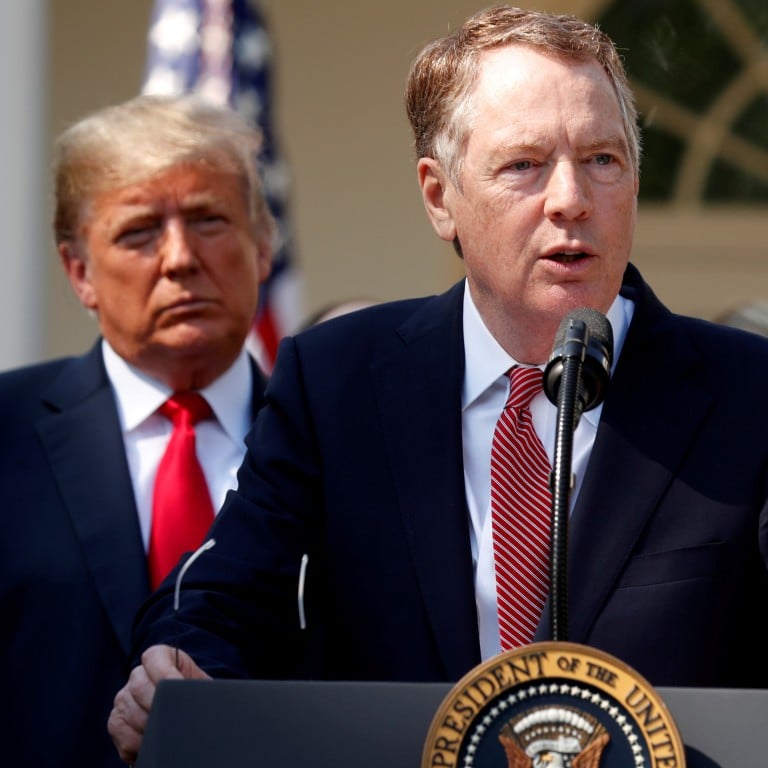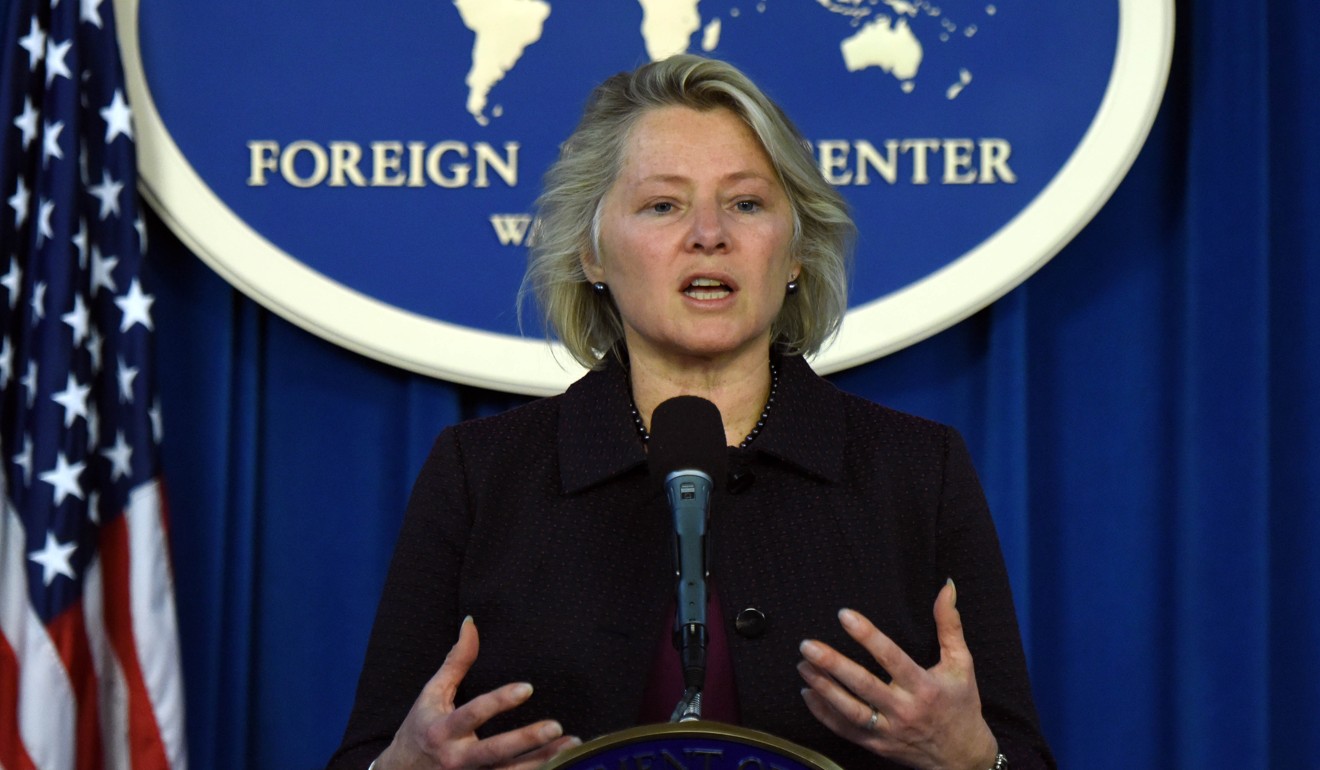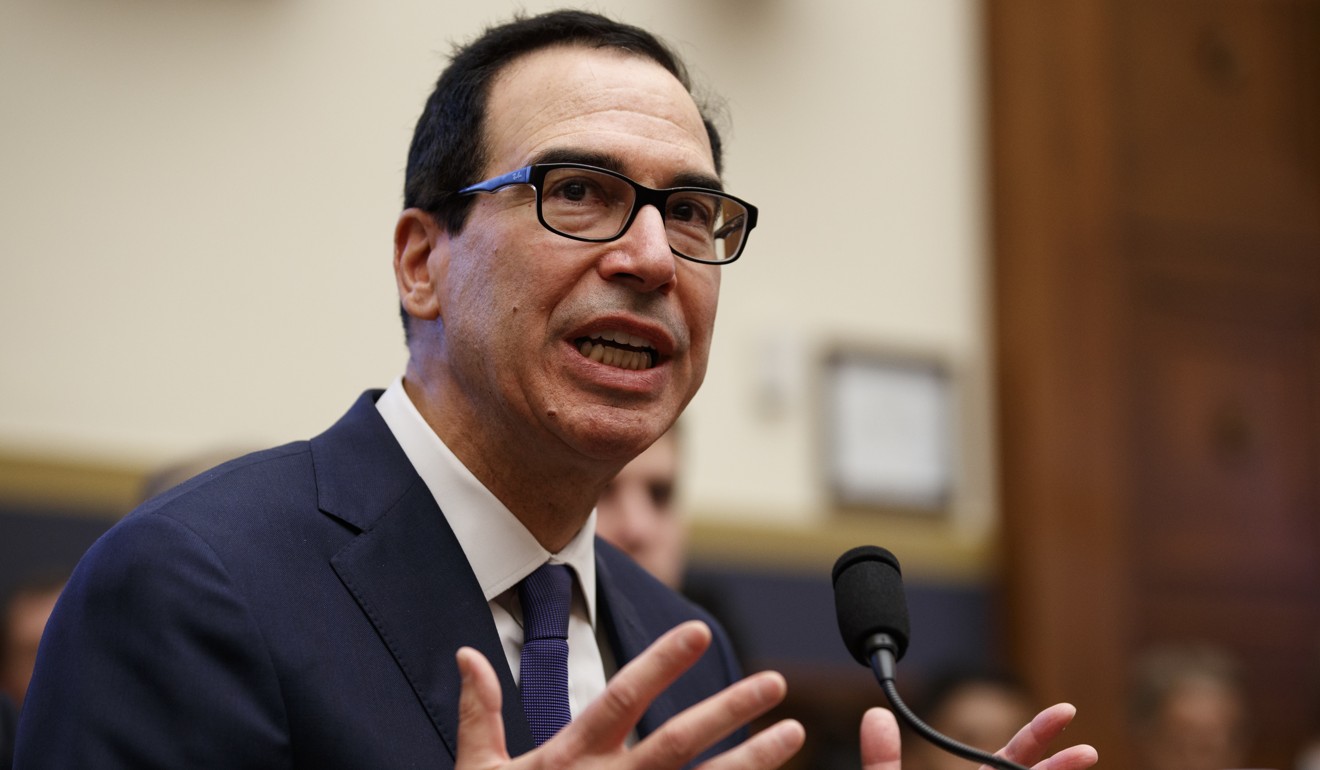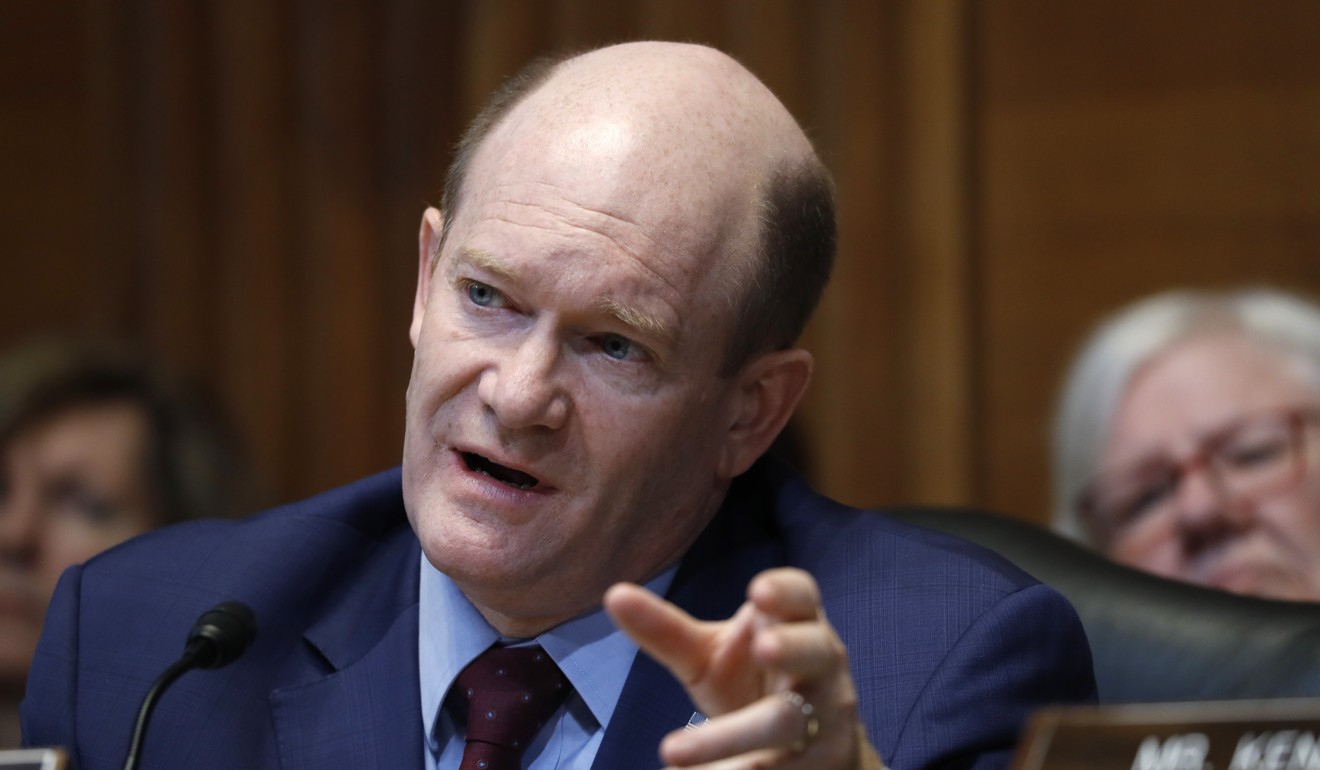
Inside Donald Trump’s blacklisting of Huawei: China hardliners prevail in battle between two White House camps
- Timing of Huawei punishment ‘suggests strongly that it’s connected to the trade negotiations because there’s no reason why that would have to happen now’
- Washington’s getting tough on the Chinese tech giant fundamentally changes the nature of the countries’ trade and tech war
The Trump administration’s decision to put Huawei Technologies on a trade blacklist was a result of a tussle between two camps in the White House, with the hardliners prevailing as the US intensifies its battle with China over technology as well as trade.
For months, advisers led by Treasury Secretary Steven Mnuchin and US Trade Representative Robert Lighthizer had been working toward an agreement to end the trade war. Dangling a victory that US President Donald Trump could claim, they had successfully held the president back from signing an executive order that he said would block Huawei from doing business in the US, former State Department officials and other observers said.
But in early May, the situation quickly deteriorated. Two days after negotiators concluded their “productive” talks in Beijing, the US accused China of reneging on crucial terms that it said had been agreed upon. Trump immediately escalated the conflict by imposing tariffs of up to 25 per cent on US$200 billion of Chinese goods, and threatened more.
On May 15, he signed the executive order banning US companies from using communications technology from anyone deemed a national security threat. His administration’s Commerce Department followed by adding Huawei to its “Entity List”, effectively barring the Chinese telecoms giant from the US market.
“It’s shocking to see how fast the deal fell apart,” said Paul Triolo, chief of global technology policy practice for the Eurasia Group, a risk consultancy. “The hawkish camp in the White House won out and the advisers leading the trade negotiations lost.”
The team leading the trade talks has its own differing priorities. Mnuchin wants China to pledge to buy more American agricultural and manufactured goods to shrink the US$419 billion trade deficit with China.
Lighthizer holds firm in his requirement that China address unfair trade practices, including intellectual property theft, forced technology transfers and subsidies to state-owned enterprises. But both agree that a deal should benefit the US.
At the other end of the spectrum, observers say, there are more hawkish advisers – including Trump’s national security adviser, John Bolton, and people from the Department of Defence and the intelligence community – who, to varying degrees, see China as an existential US threat as the next global superpower.
The Trump administration isn’t known for thoroughly thinking things through
On May 24, Trump clouded his administration’s intentions and message by calling Huawei “very dangerous” while at the same time saying the company could be a bargaining chip in a trade deal.
The analysts said the escalation against the Chinese firm appeared to be more of a political decision than a well-thought-out one. And the administration’s inconsistency on China policy is concerning and dangerous, they added: Trump and his advisers can’t seem to strike a balance between collaborating with its largest trading partner and containing the country’s misbehaviour that could compromise US interests.
The timing of Huawei’s addition to the Entity List “suggests strongly that it’s connected to the trade negotiations because there’s no reason why that would have to happen now”, said Susan Thornton, a career diplomat who was acting assistant secretary of state for East Asian and Pacific affairs for the first 18 months of the Trump administration.
“We really don’t have a China policy,” said Thornton, who retired last summer. “This administration came unprepared [regarding China]. It came with a narrative and an attitude.”

Daniel Russel, who served as assistant secretary of state for East Asia and the Pacific in the Obama administration, agreed that “holding off on [signing the] executive order until negotiations fell apart suggested it was politically motivated”.
When asked whether administration hardliners won out after trade talks fell apart, leading to the placement of Huawei on the Entity List, the Commerce Department said, “This action stems from information available to the department that provides a reasonable basis to conclude that Huawei is engaged in activities that are contrary to US national security or foreign policy interest.”
“This information includes the activities alleged in the Department of Justice’s public superseding indictment of Huawei, including alleged violations of the International Emergency Economic Powers Act (IEEPA), conspiracy to violate IEEPA by providing prohibited financial services to Iran, and obstruction of justice in connection with the investigation of those alleged violations of US sanctions,” it said.
US to speed up 5G development plans as race with China accelerates
The US government has been investigating Huawei for at least a decade. In 2005, a congressional report said that “industrial espionage is an active tool of China’s strategy for technological development”. The report singled out Huawei as a key Chinese company supporting the country’s development of 3G.
Fourteen years later, Washington’s moves have thrust Huawei into the global spotlight.
By banning the tech giant, Trump seems to be giving up on a trade deal, at least for now, Triolo said. And this time, the advisers hoping to reach an accord seem to have been blindsided.
Days before Trump’s announcement about increasing tariffs on Chinese goods, Mnuchin was still describing the trade talks as “constructive”, even after a trip to Washington by China’s lead negotiator, Liu He, and his delegation ended early with an abrupt halt to talks on May 1. Since then, no future meetings have been scheduled.
After Trump signed the executive order, Mnuchin continued to insist that the US was open to holding new talks with China if the two sides can proceed on the basis of previous negotiations.

“The Trump administration isn’t known for thoroughly thinking things through,” said Russel, now vice-president for international security and diplomacy at the Asia Society Policy Institute, a US-based think tank. “A wholesale vilification of Huawei is not going to be a successful strategy.”
“Among other reasons,” he added, “Huawei is deeply entrenched and very successful in more than two-thirds of the world.”
Unlike ZTE, another Chinese telecommunications equipment maker that was shut out of the US market last year and collapsed within weeks, Huawei relies less heavily on American components. Trump later walked back on the ZTE ban, allowing the company back into the US market after it agreed to pay a fine totalling US$1.4 billion and allow the placement of a US compliance oversight team.
Last year, Huawei released a list of 92 global suppliers that were crucial to its products. Almost two-thirds come from providers outside the US.
Huawei moves to speed judgment on case against US federal ban
The fifth-generation cellular technology, 5G, boasts download speeds 10 times as fast as 4G. It will vastly increase the connections between devices at a speed that make self-driving vehicles and interconnected home appliances possible. Huawei, which began developing the technology in 2009, has been leading in this area.
Huawei, which had revenue of US$105 billion in 2018 and employs nearly 200,000 people, is considered one of the first Chinese firms to make its name globally.
Getting tough on perhaps the nation’s most beloved company, in many Chinese minds, marked the beginning of a hostile tech cold war and fundamentally changed the nature of the battle with the US.
“It is a big escalation to single out Chinese tech giants like this,” said Triolo of the Eurasia Group. “That upset even the Chinese that were supportive of Trump’s push to reform China’s market structure and open the markets further for foreign investors.”

In the past two weeks, the US companies Qualcomm, Microsoft and Lumentum have restricted their business relationships with Huawei in response to the executive order.
German chip maker Infineon Technologies and British and Japanese mobile phone companies have also said they will suspend shipments to Huawei.
The Trump administration is moving toward issuing even more restrictions on the export of hi-tech goods to China. Over the last year, since ZTE was penalised for doing business with US-sanctioned Iran, the pace to put more Chinese technology companies on red alert has only accelerated.
Last week, the US said it was considering blacklisting five Chinese video surveillance companies including HikVision. The US Department of Homeland Security issued a warning about security threats posed by Chinese-made drones like DJI.
Trump says Huawei could be included in deal to end trade war
Earlier in May, US communications regulators denied China Mobile’s application to provide phone service in the US, citing national security risks. Federal Communications Commission Chairman Ajit Pai said the commission was “looking at” licenses previously granted to two other carriers, China Unicom and China Telecom.
The Commerce Department will soon recommend rolling back regulations making it easier for US companies to export certain goods that have both civilian and military purposes, Politico reported last week. The department will also recommend ending a general policy of approving export licenses for that group of goods if they are intended for civilian use and instead require case-by-case reviews.
“The endgame is to try to build a global 5G network that has no Chinese equipment in it,” Triolo said. “There is a huge constituency that doesn’t want to see China dominate that technology.”
Democratic Senator Chris Coons, among many US lawmakers, said at a Senate Judiciary Committee hearing on 5G wireless development on May 14 that he was concerned “about the ways in which China is now developing what will be the most important technological advance of this coming decade”.
And the fact that it will allow China to “potentially disrupt what will be central networks that drive everything from our vehicles to health care, national security to our power system, is chilling and concerning”.

But how to build the latest network without Chinese firms is not clear. Just last month, the Netherlands’ leading wireless carrier, KPN, chose Huawei over the existing vendor, Sweden’s Ericsson, to provide 5G network equipment because its bid was 60 per cent cheaper.
Senator Lindsey Graham, the Republican chairman of the Judiciary Committee, said at the hearing that “we need to up our 5G game because if there's nobody other than China [that can provide the technology], we’ve got a problem.”
Without a clear map, observers said, the antagonistic move to ban Huawei could have catastrophic consequences for US consumers, the American semiconductor industry and, more importantly, the global advancement of 5G, which will change the way humans live and communicate.
“The second- and third-order consequences are barely understood and hard to evaluate,” Russel said. “Putting up a wall around the United States is not a growth strategy and will not stop either the behaviour that is objectionable, or that they’re afraid of.”
US Commerce Department scales back restrictions on Huawei
In a further sign of US policy inconsistency, the Commerce Department softened the ban a week after it was imposed, granting a 90-day waiver for US companies to help Huawei maintain its existing networks. The reprieve ends on August 19.
“In short, this license will allow operations to continue for existing Huawei mobile phone users and rural broadband networks,” said Commerce Secretary Wilbur Ross.
So far, both Huawei and the Chinese government have been relatively restrained in their responses.
Huawei’s typically taciturn founder, Ren Zhengfei, said in a rare interview with Chinese state broadcaster CCTV recently that “we will ultimately embrace each other because we want to work together with them to make contributions to society”.
He urged the news media not to point fingers. “The media should understand that these US companies and Huawei share the same fate,” he said. “We are both players in the market economy.”
This week, China asked its government officials and state media outlets to avoid being overly and often unnecessarily critical of the United States and its key players, hoping to appeal to potentially sympathetic voices on the other side of the trade war.
Huawei boss dismisses Trump trade deal suggestion
In the best-case scenario, observers said, Huawei should negotiate an agreement with the Commerce Department, as ZTE did. But today’s White House is different, according to Triolo and Russel, and is in a resistance mode where China hawks prevail.
“It never hurts to sit down and have a conversation about perhaps firewalls or safeguards that could be created,” said Christopher Campbell, assistant secretary of the US Treasury for financial institutions until 2018. “[But] I don’t know if there’s ever going to be certainty from the US perspective on how well those firewalls would be maintained or whether the technology would be free of government intervention or manipulation.”
Said Triolo of the Huawei situation: “Nobody really knows how this is going to end.”
“But what we know for sure is that the cost to cutting off Huawei from the global 5G supply chain is going to be astronomical. We have entered an uncharted territory.”
Additional reporting by Robert Delaney

